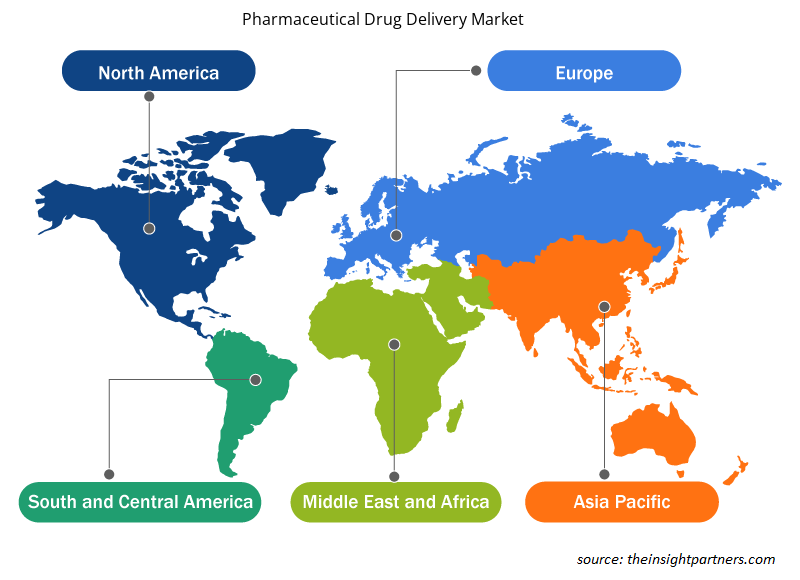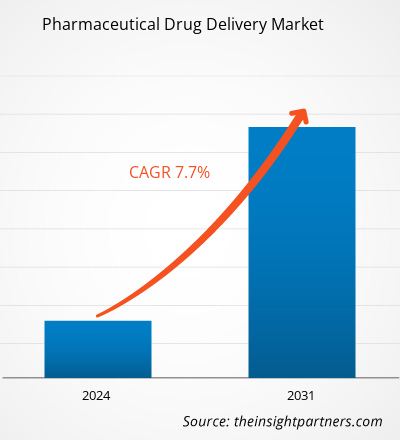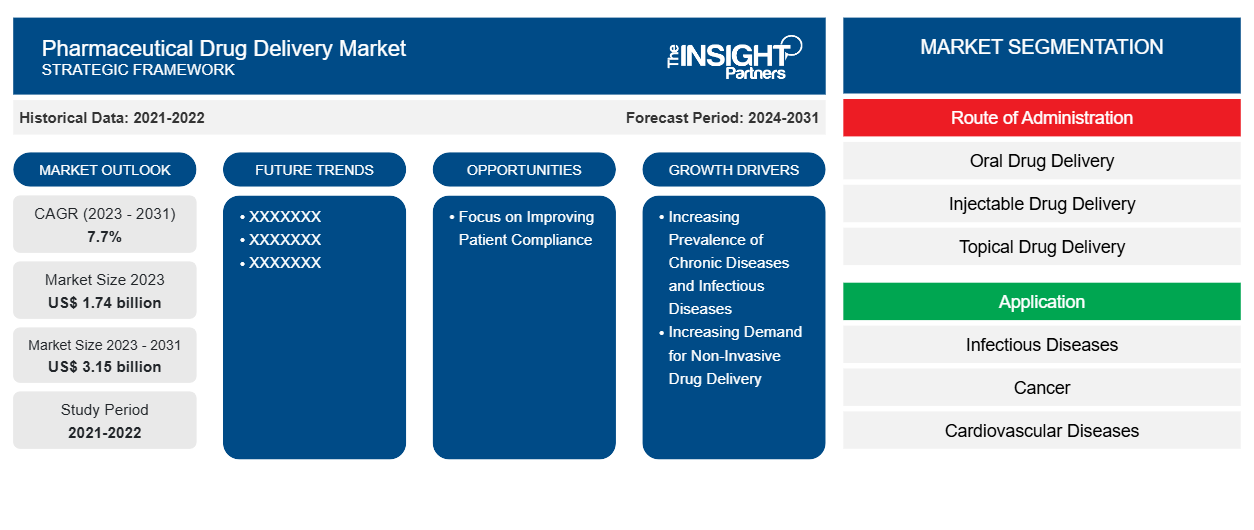تم تقدير حجم سوق توصيل الأدوية الصيدلانية بنحو 1.74 مليار دولار أمريكي في عام 2023 ومن المتوقع أن يصل إلى 3.15 مليار دولار أمريكي بحلول عام 2031؛ ومن المتوقع أن يسجل معدل نمو سنوي مركب بنسبة 7.7٪ حتى عام 2031. ومن المرجح أن تظل التطورات الاستراتيجية وإطلاق المنتجات من الاتجاهات الرئيسية في سوق توصيل الأدوية الصيدلانية.
تحليل سوق توصيل الأدوية الصيدلانية
إن زيادة عدد كبار السن، وزيادة الرعاية الصحية المنزلية، وزيادة انتشار الأمراض المزمنة، وزيادة الإجراءات الجراحية، وزيادة انتشار الأمراض المعدية هي عوامل تدفع نمو سوق توصيل الأدوية الصيدلانية. بالإضافة إلى ذلك، أدى زيادة موافقة إدارة الغذاء والدواء على أجهزة توصيل الأدوية غير الجراحية المختلفة وزيادة الإنفاق على البحث والتطوير من قبل شركات الأدوية لتطوير الأدوية إلى زيادة الطلب على توصيل الأدوية الصيدلانية.
نظرة عامة على سوق توصيل الأدوية الصيدلانية
تُستخدم أنظمة توصيل الأدوية في المقام الأول للتوصيل المتحكم فيه أو المستهدف للعديد من العوامل العلاجية لعلاج أمراض مختلفة أو تحسين صحة المرضى. تعد الصين واحدة من الأسواق الناشئة الرئيسية في سوق توصيل الأدوية الصيدلانية. يتم دفع سوق أجهزة توصيل الأدوية في الصين من خلال التقدم التكنولوجي في صناعة الأجهزة الطبية والارتفاع في التركيز على تشخيص وعلاج الأمراض المزمنة بين البالغين وكبار السن. من المتوقع أن توفر الصين فرصًا مربحة للاعبين المحليين والدوليين لتصنيع وتسويق أجهزة توصيل الأدوية في البلاد خلال فترة التنبؤ.
قم بتخصيص هذا التقرير ليناسب متطلباتك
ستحصل على تخصيص لأي تقرير - مجانًا - بما في ذلك أجزاء من هذا التقرير، أو تحليل على مستوى الدولة، وحزمة بيانات Excel، بالإضافة إلى الاستفادة من العروض والخصومات الرائعة للشركات الناشئة والجامعات
-
احصل على أهم اتجاهات السوق الرئيسية لهذا التقرير.ستتضمن هذه العينة المجانية تحليلاً للبيانات، بدءًا من اتجاهات السوق وحتى التقديرات والتوقعات.
محركات وفرص سوق توصيل الأدوية الصيدلانية
تزايد الطلب على توصيل الأدوية غير الجراحية
تتضمن طرق توصيل الأدوية غير الجراحية عادةً طرق توصيل الأدوية غير المؤلمة عبر الحواجز البيولوجية للأسطح المخاطية أو الجلد. يمكن أن تؤدي طريقة توصيل الأدوية هذه إلى تحسين الوصول إلى الأدوية وتحسين ملفات تعريف سلامة الأدوية والالتزام بأنظمة العلاج. يفضل المرضى طرق توصيل الأدوية غير الجراحية بسبب المزايا التي تتمتع بها على إعطاء الأدوية عن طريق الحقن مثل عدم حدوث إصابات أو عدوى بسبب الإبر والفعالية من حيث التكلفة لطرق التوصيل غير الجراحية. بعض طرق توصيل الأدوية غير الجراحية الأكثر شيوعًا هي: موضعي، عبر الجلد السلبي، عبر الجلد النشط (اختراق معزز بمساعدة الجهاز)، عبر الغشاء المخاطي، عبر الغشاء العيني، والتوصيل عبر غشاء السنخ من الأدوية المستنشقة. يتضمن توصيل الأدوية باستخدام طرق غير جراحية تقليل تواتر الجرعات وجداول الجرعات المبسطة. علاوة على ذلك، يمكن لأنظمة التوصيل هذه أن تقلل بشكل كبير من تكلفة الاستخدام السريري حيث يمكن للمرضى إعطاء الأدوية بأنفسهم من خلال هذه الطرق. وبالتالي، فإن الطلب المتزايد على أنظمة توصيل الأدوية غير الجراحية يدفع نمو سوق أنظمة توصيل الأدوية.
التركيز على تحسين التزام المرضى بالعلاج – فرصة في سوق توصيل الأدوية الصيدلانية
إن انخفاض التزام المريض بالعلاج يشكل مصدر قلق ملحوظ بين الأطباء ومصنعي الأجهزة الطبية. ومن ثم، يركز المصنعون على تطوير أنظمة توصيل الأدوية البديهية وسهلة الاستخدام والتي توفر راحة عالية للمريض. ويسعى المرضى ومقدمو الرعاية والأطباء إلى إيجاد حلول أكثر تركيزًا على المريض، وتقييم أنظمة التوصيل وخيارات التعبئة والتغليف لتشجيع المرضى على تناول أدويتهم حسب التوجيهات. وتعد الجرعات المقاسة بدقة والتغليف سهل الاستخدام مع وضع علامات واضحة أمرًا ضروريًا لتلبية احتياجات الاكتفاء الذاتي اليوم. يتم تعبئة عبوة الجرعة الواحدة أو الحاوية بدقة لاحتواء الأدوية بكميات مخصصة لجرعة واحدة. تعمل هذه الميزات على تقليل أخطاء الدواء لأن هوية الدواء يتم تأكيدها بسرعة، وتضمن العبوة أن يأخذ المرضى الجرعة الصحيحة من الأدوية. يركز مصنعو الأدوية الآن على أنظمة توصيل الأدوية التي توفر سهولة الاستخدام والقدرة على النقل والراحة للمرضى الذين يتناولون الأدوية في أماكن أخرى غير المنزل. وقد وجد أن التزام المريض يكون أعلى بكثير عندما يتم إعطاء الأدوية بطرق غير جراحية، حيث يعانون من انخفاض الألم أثناء الإجراء.
تقرير تحليل تجزئة سوق توصيل الأدوية الصيدلانية
إن القطاعات الرئيسية التي ساهمت في اشتقاق تحليل سوق توصيل الأدوية الصيدلانية هي طريق الإدارة والتطبيق والمستخدم النهائي.
- بناءً على طريق الإدارة، يتم تقسيم سوق توصيل الأدوية الصيدلانية إلى توصيل الأدوية عن طريق الفم، وتوصيل الأدوية عن طريق الحقن، وتوصيل الأدوية الموضعية، وتوصيل الأدوية عن طريق العين، وتوصيل الأدوية عن طريق الرئة، وتوصيل الأدوية عن طريق الأنف، وتوصيل الأدوية عبر الغشاء المخاطي، وتوصيل الأدوية القابلة للزرع. احتل قطاع توصيل الأدوية عن طريق الحقن أكبر حصة سوقية في عام 2023.
- من حيث التطبيق، يتم تقسيم سوق توصيل الأدوية الصيدلانية إلى الأمراض المعدية والسرطان وأمراض القلب والأوعية الدموية والسكري وأمراض الجهاز التنفسي واضطرابات الجهاز العصبي المركزي وأمراض المناعة الذاتية وغيرها. احتل قطاع السرطان أكبر حصة سوقية في عام 2023.
- بناءً على المستخدم النهائي، يتم تقسيم سوق توصيل الأدوية الصيدلانية إلى المستشفيات ومؤسسات الرعاية المنزلية ومراكز الرعاية الخارجية والعيادات وغيرها. احتل قطاع المستشفيات أكبر حصة سوقية في عام 2023.
تحليل حصة سوق توصيل الأدوية الصيدلانية حسب المنطقة الجغرافية
ينقسم النطاق الجغرافي لتقرير سوق توصيل الأدوية الصيدلانية بشكل أساسي إلى خمس مناطق: أمريكا الشمالية، ومنطقة آسيا والمحيط الهادئ، وأوروبا، والشرق الأوسط وأفريقيا، وأمريكا الجنوبية والوسطى.
سيطرت أمريكا الشمالية على سوق توصيل الأدوية الصيدلانية. يتميز نمو السوق في أمريكا الشمالية بالطلب المتزايد على أدوية الأمراض المعدية من المرضى، ووجود لاعبين رئيسيين في السوق، وزيادة إطلاق المنتجات، وزيادة انتشار الأمراض المزمنة، والبحث والتطوير المكثف الذي أجرته المعاهد الأكاديمية والبحثية والصيدلانية. بسبب التقدم التكنولوجي، يمكن إدارة علاجات التسريب بأمان وفعالية في المنزل. تطور العلاج بالتسريب في إعدادات الرعاية المنزلية إلى علاج فعال من حيث التكلفة تمامًا، وقد أدى ذلك إلى إنشاء علاج للمرضى الداخليين في المستشفى أو مرفق التمريض الماهر، وبالتالي دفع نمو سوق توصيل الأدوية في أمريكا الشمالية. علاوة على ذلك، من المتوقع أن تسجل منطقة آسيا والمحيط الهادئ أعلى معدل نمو سنوي مركب في السنوات القادمة.
رؤى إقليمية حول سوق توصيل الأدوية الصيدلانية
لقد قام المحللون في Insight Partners بشرح الاتجاهات والعوامل الإقليمية المؤثرة على سوق توصيل الأدوية الصيدلانية طوال فترة التوقعات بشكل شامل. يناقش هذا القسم أيضًا قطاعات سوق توصيل الأدوية الصيدلانية والجغرافيا في جميع أنحاء أمريكا الشمالية وأوروبا ومنطقة آسيا والمحيط الهادئ والشرق الأوسط وأفريقيا وأمريكا الجنوبية والوسطى.

- احصل على البيانات الإقليمية المحددة لسوق توصيل الأدوية الصيدلانية
نطاق تقرير سوق توصيل الأدوية الصيدلانية
| سمة التقرير | تفاصيل |
|---|---|
| حجم السوق في عام 2023 | 1.74 مليار دولار أمريكي |
| حجم السوق بحلول عام 2031 | 3.15 مليار دولار أمريكي |
| معدل النمو السنوي المركب العالمي (2023 - 2031) | 7.7% |
| البيانات التاريخية | 2021-2022 |
| فترة التنبؤ | 2024-2031 |
| القطاعات المغطاة |
حسب طريق الإدارة
|
| المناطق والدول المغطاة |
أمريكا الشمالية
|
| قادة السوق وملفات تعريف الشركات الرئيسية |
|
كثافة اللاعبين في سوق توصيل الأدوية الصيدلانية: فهم تأثيرها على ديناميكيات الأعمال
يشهد سوق توصيل الأدوية الصيدلانية نموًا سريعًا، مدفوعًا بالطلب المتزايد من المستخدم النهائي بسبب عوامل مثل تفضيلات المستهلكين المتطورة والتقدم التكنولوجي والوعي المتزايد بفوائد المنتج. ومع ارتفاع الطلب، تعمل الشركات على توسيع عروضها والابتكار لتلبية احتياجات المستهلكين والاستفادة من الاتجاهات الناشئة، مما يؤدي إلى زيادة نمو السوق.
تشير كثافة اللاعبين في السوق إلى توزيع الشركات أو المؤسسات العاملة في سوق أو صناعة معينة. وهي تشير إلى عدد المنافسين (اللاعبين في السوق) الموجودين في مساحة سوق معينة نسبة إلى حجمها أو قيمتها السوقية الإجمالية.
الشركات الرئيسية العاملة في سوق توصيل الأدوية الصيدلانية هي:
- شركة فايزر
- شركة باير ايه جي
- خدمات جونسون آند جونسون، المحدودة
- شركة نوفارتيس ايه جي
- 3م
- بنغلاديش
إخلاء المسؤولية : الشركات المذكورة أعلاه ليست مرتبة بأي ترتيب معين.

- احصل على نظرة عامة على أهم اللاعبين الرئيسيين في سوق توصيل الأدوية الصيدلانية
أخبار سوق توصيل الأدوية الصيدلانية والتطورات الأخيرة
يتم تقييم سوق توصيل الأدوية الصيدلانية من خلال جمع البيانات النوعية والكمية بعد البحث الأولي والثانوي، والتي تتضمن منشورات الشركات المهمة وبيانات الجمعيات وقواعد البيانات. فيما يلي قائمة بالتطورات في سوق توصيل الأدوية الصيدلانية والاستراتيجيات:
- تعاونت مجموعة ستيفاناتو مع شركة ريسيفهارم لتطوير وتصنيع حقن قابلة للتعبئة مسبقًا والتي سيتم دمجها في جهاز استنشاق ضباب ناعم جديد لاستنشاق المنتجات البيولوجية الحساسة. يهدف التعاون الاستراتيجي الجديد إلى توفير عبوات أولية مبتكرة لشركات الأدوية والمستحضرات الصيدلانية الحيوية التي تستخدم أجهزة استنشاق الضباب الناعم المملوكة لشركة ريسيفهارم. (المصدر: مجموعة ستيفاناتو، موقع الشركة على الإنترنت، 2023)
- أطلقت شركة Coherus BioSciences, Inc. جهاز الحقن UDENYCA على الجسم (OBI) باستخدام منصة توصيل الأدوية القابلة للارتداء LTS Sorrel. UDENYCA (pegfilgrastim-cbqv) هو عبارة عن مستحضر مشابه حيويًا لـ pegfilgrastim يتم إعطاؤه في اليوم التالي للعلاج الكيميائي لتقليل حدوث العدوى كما يتجلى في نقص العدلات المصحوب بالحمى. (المصدر: Cision US Ltd، بيان صحفي، 2024)
تقرير سوق توصيل الأدوية الصيدلانية - التغطية والنتائج المتوقعة
يقدم تقرير "حجم سوق توصيل الأدوية الصيدلانية والتوقعات (2021-2031)" تحليلاً مفصلاً للسوق يغطي المجالات التالية:
- حجم السوق والتوقعات على المستويات العالمية والإقليمية والوطنية لجميع قطاعات السوق الرئيسية التي يغطيها النطاق
- ديناميكيات السوق مثل المحركات والقيود والفرص الرئيسية
- الاتجاهات المستقبلية الرئيسية
- تحليل مفصل لقوى PEST/Porter الخمس وSWOT
- تحليل السوق العالمي والإقليمي الذي يغطي اتجاهات السوق الرئيسية واللاعبين الرئيسيين واللوائح والتطورات الأخيرة في السوق
- تحليل المشهد الصناعي والمنافسة الذي يغطي تركيز السوق، وتحليل خريطة الحرارة، واللاعبين البارزين، والتطورات الأخيرة
- ملفات تعريف الشركة التفصيلية
- التحليل التاريخي (سنتان)، سنة الأساس، التوقعات (7 سنوات) مع معدل النمو السنوي المركب
- تحليل PEST و SWOT
- حجم السوق والقيمة / الحجم - عالمي، إقليمي، بلد
- الصناعة والمنافسة
- مجموعة بيانات إكسل
التقارير الحديثة
تقارير ذات صلة
شهادات العملاء
سبب الشراء
- اتخاذ قرارات مدروسة
- فهم ديناميكيات السوق
- تحليل المنافسة
- رؤى العملاء
- توقعات السوق
- تخفيف المخاطر
- التخطيط الاستراتيجي
- مبررات الاستثمار
- تحديد الأسواق الناشئة
- تحسين استراتيجيات التسويق
- تعزيز الكفاءة التشغيلية
- مواكبة التوجهات التنظيمية























 احصل على عينة مجانية ل - سوق توصيل الأدوية الصيدلانية
احصل على عينة مجانية ل - سوق توصيل الأدوية الصيدلانية